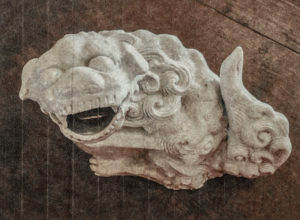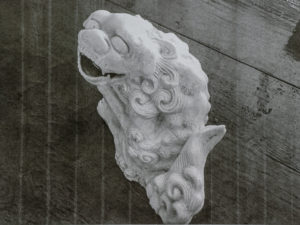 Apologies to FK, who sent me a photo of her Temple Lion sometime in the deep past. She asked if her Chinese ceramic was in fact late Ming Dynasty (1368-1644) and, what is a temple lion, and why a lion? Yes, this response is late, FK. I feel blessed that many people send me photos for this column. keep it UP!
Apologies to FK, who sent me a photo of her Temple Lion sometime in the deep past. She asked if her Chinese ceramic was in fact late Ming Dynasty (1368-1644) and, what is a temple lion, and why a lion? Yes, this response is late, FK. I feel blessed that many people send me photos for this column. keep it UP!
Buddhist Temple Lions, pictured as the male of the species, sat on his haunches, sometimes with one foot raised on a brocade ball. He appears fierce, with his head raised in a wide roar or snarl, with a tongue sometimes visible. The mane looks as stylized (abundant curls) as the tail, but the ears and the eyes are emphasized, both bulging from the head. For this reason, he is sometimes called a Foo Dog. He bears his teeth in a fantastic reference to fearlessness, his backbone usually knobby and coiled. Often times, the lion will be saddled, or caparisoned, considered highly symbolic. In Asian art a “gap” between the spiritual and the material doesn’t exist, and these symbols truly “live.”
What do these symbols mean?
The term “temple lion” refers to this object’s former position on the roof corners of a Buddhist temple. The Buddha, formerly known as Shakyamuni, was himself a member of the lion clan called “Shakya.” Why then does the lion roar, and why do they place him on the edge line of a temple roof? Because the lion roars out the dharma, the Four Noble Truths, across the landscape for all to hear.
The lion represents a fearless ensign of nobility. Known as the kings of the animal world with no natural enemy. They live in clans, and the male lion’s single role is to protect the clan. They do not hunt, the females do. So we hold the male lion in the highest regard.
All the “sons” of Buddha, the Bodhisattvas, are Buddha’s lions, and as FK’s figure represents a real animal, the Bodhisattvas agree to remain in the animal world as material beings, until all sentiment beings are free from suffering.
FK’s lion embodies a protector creature, found at entrances of monasteries, shrines and temples. The white color references the “snow lion,” the loftiest being on a high mountain. Of course, a reference to a mountain represents the “peak” of wisdom.
Originally FK’s lion came with a brother. Two temple lions are placed at corners of a structure, reminding devotees of compassion and fierce wisdom.
FK asks the date of her lion and suspects the curator of the Pasadena Asian Art Museum correct in the date of 1620 (late Ming). The way the pottery body was fired, leaving certain “gaps” in finishing, indicates this early date.
Some temple lions are saddled or caparisoned
 The great beasts signifies a warrior’s companion in war. The tradition lives on today in state funerals, when a riderless horse is led, saddled, in the funeral procession with the stirrups inverted, implying the warrior fell in battle.
The great beasts signifies a warrior’s companion in war. The tradition lives on today in state funerals, when a riderless horse is led, saddled, in the funeral procession with the stirrups inverted, implying the warrior fell in battle.
Genghis Khan, the Mongols, and the Tartars began this custom, since their war horses traveled through the gate in the sky to serve a warrior master. A warrior should never walk, but always remain mounted. You can see how this symbolism “works” for devotees of the Buddha.
Asian ceramics are difficult to date because once a style is deemed ‘perfected,’ that style lives on for thousands of years in the same “image.” It takes a real expect to date a piece of Asian ceramic, and close physical examination. However, FK’s piece has that authentic Ming quality to my eye, which makes the Ming period one of the most desirable in Asian ceramics. The glaze also indicates quality very difficult to master in the 15th century. In the West we call this Blanc de chine, a tradition of pure white ceramic slip with an almost clear glaze. This is meant to show the purity of the material, another important religious reference. The value, FK, I find hard to ascertain in photos. If the date is 1620 and the piece is in good condition, you have a treasure on your hands at upwards of $3,000.
Pingback: Buddhist Temple Lion Ming or Not? - Elizabeth Appraisals